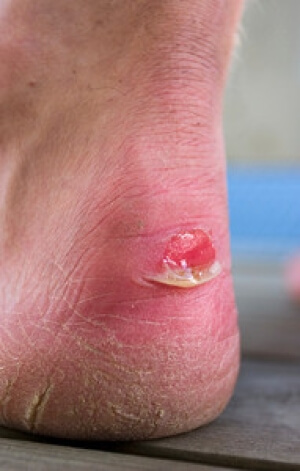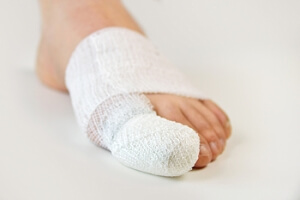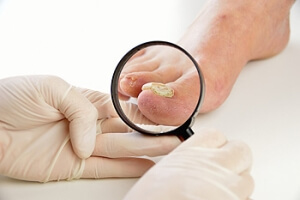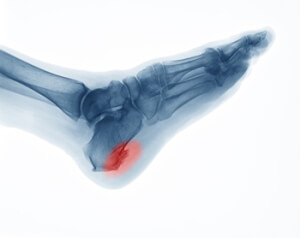
Obesity and the Feet
Obesity is a common problem in American society. Approximately one third of the U.S. population is obese. Obesity is defined as a body mass index greater than 30. Obesity has the power to affect different aspects of the body, and one of the most common problems it causes is foot pain. There have been many studies that found a connection between an increased BMI and foot problems. A simple activity such as walking up a flight of stairs can increase pressure on the ankle by four to six times.
Being overweight causes the body to compensate for the extra weight by changing the way it moves. Consequently, people who struggle with obesity commonly have arch problems in their feet. Obesity causes the arch to break by stretching the ligaments and tendons that hold the bones in the foot together. When the arch lowers, the foot may eventually fall flat. Collapsed foot arches fail to provide adequate shock absorption which eventually leads to foot pain. Other conditions that may be caused by flat feet are pronation, plantar fasciitis, weak ankles, and shin splints.
Foot problems that are caused by obesity may be treated by wearing proper footwear. Proper shoes will allow your feet to have better circulation around the arch and ankle. Additionally, those with obesity often discover that typical heel pain remedies are not effective for them. They will find that their plantar fascia is easily injured, and it is often inflamed. The best way to treat this problem is to implement lifestyle changes. A few good ways to improve your diet are to reduce calories, fill up on fruits and veggies, and to limit sugars.
Custom foot orthotics can prevent foot problems if you’re carrying excess weight or are trying to lose weight. The purpose of orthotics is to provide shock absorption to decrease the amount of stress on the joints to prevent arthritis.
What Causes a Blister to Develop?
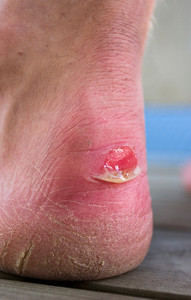 If you frequently run or wear shoes that are too tight, you may develop a blister. This may be a result of excess friction that occurs on a portion of the skin. A blister is defined as a small bubble that is filled with clear liquid and may naturally drain when the affected area of skin has healed. The top layer of the skin may become raw and painful, and the body’s natural defense mechanism may be to develop a blister, which will protect the skin that has been damaged. There may be additional reasons for blisters to develop, which may include allergic reactions, sunburns, or medical conditions such as impetigo. If a blister should become infected, it may appear to be yellow or green, in addition to possibly causing pain and discomfort. If you have a blister on your foot that will not heal, it is suggested that you speak to a podiatrist.
If you frequently run or wear shoes that are too tight, you may develop a blister. This may be a result of excess friction that occurs on a portion of the skin. A blister is defined as a small bubble that is filled with clear liquid and may naturally drain when the affected area of skin has healed. The top layer of the skin may become raw and painful, and the body’s natural defense mechanism may be to develop a blister, which will protect the skin that has been damaged. There may be additional reasons for blisters to develop, which may include allergic reactions, sunburns, or medical conditions such as impetigo. If a blister should become infected, it may appear to be yellow or green, in addition to possibly causing pain and discomfort. If you have a blister on your foot that will not heal, it is suggested that you speak to a podiatrist.
Blisters may appear as a single bubble or in a cluster. They can cause a lot of pain and may be filled with pus, blood, or watery serum. If your feet are hurting, contact one of our podiatrists of Apple Podiatry Group. Our doctors can provide the care you need to keep you pain-free and on your feet.
Foot Blisters
Foot blisters are often the result of friction. This happens due to the constant rubbing from shoes, which can lead to pain.
What Are Foot Blisters?
A foot blister is a small fluid-filled pocket that forms on the upper-most layer of the skin. Blisters are filled with clear fluid and can lead to blood drainage or pus if the area becomes infected.
Symptoms
(Blister symptoms may vary depending on what is causing them)
- Bubble of skin filled with fluid
- Redness
- Moderate to severe pain
- Itching
Prevention & Treatment
In order to prevent blisters, you should be sure to wear comfortable shoes with socks that cushion your feet and absorb sweat. Breaking a blister open may increase your chances of developing an infection. However, if your blister breaks, you should wash the area with soap and water immediately and then apply a bandage to the affected area. If your blisters cause severe pain it is important that you call your podiatrist right away.
If you have any questions, please feel free to contact our offices located in Arlington Fort Worth, And Flower Mound, TX . We offer the newest diagnostic and treatment technologies for all your foot care needs.
Blisters
Blisters are small pockets of fluid that occur on the top layers of the skin for several reasons. Friction, burns, and diseases are all known causes of blisters. Smaller blisters are known as vesicles, while larger blisters are referred to as bulla. The fluid inside the bubble can be blood, pus, or serum; which is a clear liquid that protects the skin. In most cases, blisters are not a major health issue, but they can be an indicator of a more serious condition.
Causes of blisters vary. Blisters are commonly caused by wearing poorly fitted shoes that rub against the foot. However, there are many other causes besides from friction; including burns, sunburn, insect bites, frostbite, poison ivy/oak, chemical exposure, impetigo, eczema, viral infections, and more.
Most blisters heal by themselves and do not require immediate medical care. If you have a blister, do not pop it since this may cause infection; it is advised to put a bandage over the blister to protect it. If the blister is large, causes pain, or if you have a fever, it is recommended that you see a doctor who can provide proper care. Blisters are easy to diagnose, and if considered prudent by the doctor, can easily be drained of fluid with a sterile needle as well.
To prevent blisters on the feet, wear shoes that fit properly and don’t cause rubbing. Socks can help prevent friction and it is recommended that you wear them if you are wearing shoes. Hand blisters can be avoided by wearing gloves during activities that cause friction against the hand. If you have a blister that pops, do not remove the dead skin, wash the area, apply antibiotic ointment, and cover with a bandage. It is okay in most cases to not seek immediate medical care for a blister if it was just caused by friction. However, if the blister causes pain or does not go away, it is suggested that you see a doctor for a diagnosis.
Tips for Senior Foot Care
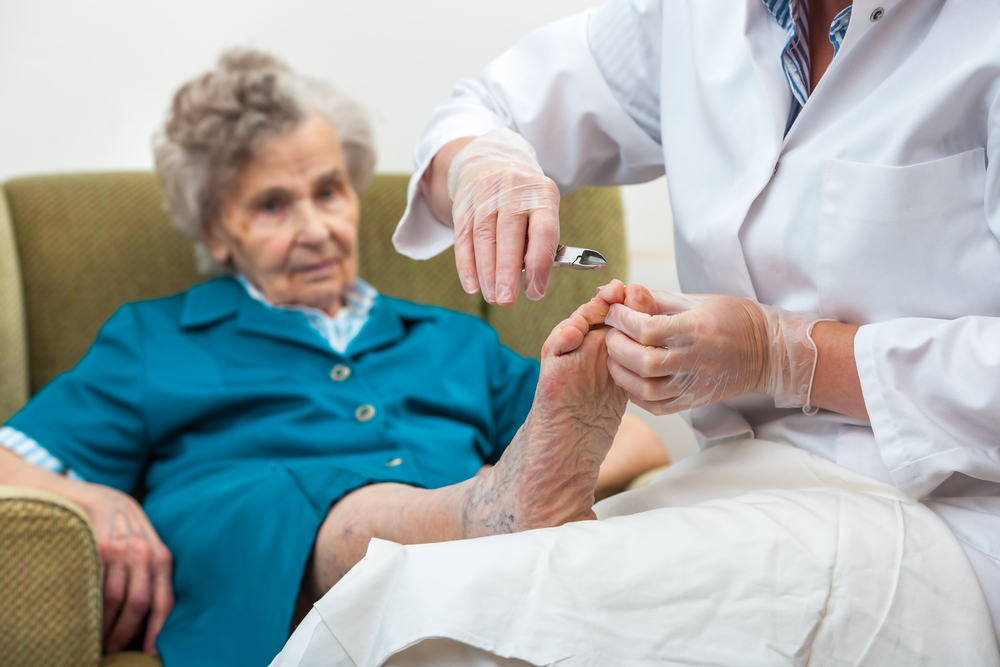 Many elderly people may find it difficult to practice daily foot care. It’s important for seniors to wear shoes that fit comfortably, and this may prevent uncomfortable conditions from developing. These may include corns, calluses, bunions, or ingrown toenails. Research has shown the feet may change size or become wider, and it is recommended to measure them to determine the proper shoe size. Many seniors may spend the day sitting down, and poor circulation may gradually develop. This may be avoided by resisting the urge to cross the legs, in addition to frequently walking and performing gentle stretches. A common ailment that many elderly people notice is dry skin. Mild relief may be found when a moisturizer is applied several times per day. If you have questions about how to care for elderly feet, it is suggested to consult with a podiatrist.
Many elderly people may find it difficult to practice daily foot care. It’s important for seniors to wear shoes that fit comfortably, and this may prevent uncomfortable conditions from developing. These may include corns, calluses, bunions, or ingrown toenails. Research has shown the feet may change size or become wider, and it is recommended to measure them to determine the proper shoe size. Many seniors may spend the day sitting down, and poor circulation may gradually develop. This may be avoided by resisting the urge to cross the legs, in addition to frequently walking and performing gentle stretches. A common ailment that many elderly people notice is dry skin. Mild relief may be found when a moisturizer is applied several times per day. If you have questions about how to care for elderly feet, it is suggested to consult with a podiatrist.
Proper foot care is something many older adults forget to consider. If you have any concerns about your feet and ankles, contact one of our podiatrists from Apple Podiatry Group. Our doctors can provide the care you need to keep you pain-free and on your feet.
The Elderly and Their Feet
As we age we start to notice many changes in our body, but the elder population may not notice them right away. Medical conditions may prevent the elderly to take notice of their foot health right away. Poor vision is a lead contributor to not taking action for the elderly.
Common Conditions
- Neuropathy – can reduce feeling in the feet and can hide many life-threatening medical conditions.
- Reduced flexibility – prevents the ability of proper toenail trimming, and foot cleaning. If left untreated, it may lead to further medical issues.
- Foot sores – amongst the older population can be serious before they are discovered. Some of the problematic conditions they may face are:
- Gouging toenails affecting nearby toe
- Shoes that don’t fit properly
- Pressure sores
- Loss of circulation in legs & feet
- Edema & swelling of feet and ankles
Susceptible Infections
Diabetes and poor circulation can cause general loss of sensitivity over the years, turning a simple cut into a serious issue.
If you have any questions please feel free to contact our offices located in Arlington Fort Worth, And Flower Mound, TX . We offer the newest diagnostic and treatment technologies for all your foot and ankle needs.
Taking Care of Elderly Feet
Many foot diseases and conditions become more serious and common among the elderly. Some of these conditions include diabetic ulcers, ingrown toenails, fungus, arthritis, corns, and calluses. Unfortunately, it may be harder for older adults to take care of their own feet, but there are some precautions they can take in order to avoid any serious conditions.
Dry, cracked heels tend to be a common problem for older people. In order to avoid this, you should always keep your feet clean and well moisturized. Special feet moisturizers should be used as average lotions might not provide enough moisture for dry and cracked heels. Daily foot inspections are crucial for the elderly to detect any irregularities in their earliest stages. During the aging process, blood circulation tends to slow down causing older people to not feel their feet as well as they used to. This often results in foot problems going unnoticed.
Fungal and bacterial conditions thrive on elderly feet because older adults are less likely to keep their feet clean and dry; this makes it easier for bacteria to take hold in their dry, cracked skin. Elderly people should be sure to thoroughly dry their feet, especially in between the toes, after bathing. This will help them avoid developing any fungal infections. Additionally, clean cotton socks should be worn after the feet are dried.
Cutting toenails straight across will help prevent ingrown toenails. When toenails are cut too lose, the nail might break through the skin resulting in an ingrown nail. Clippers should be used to cut the nails in order to make the cut even.
Elderly people who have diabetes are at risk of developing serious foot problems that may lead to amputation. Ulcers that are left untreated can lead to gangrene. Dry and cracked feet, fungus, and untended cuts under the nails may also lead to infections.
Fortunately, Medicare covers many different types of services for foot care. Elderly people with any of these foot conditions should seek the help of a podiatrist and perform daily foot inspections in order to ensure that they have healthy feet.
Causes of Broken Toes
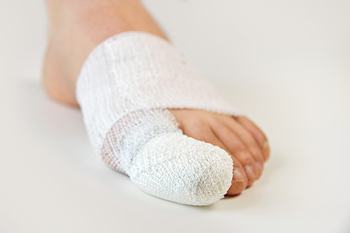 The bones that are located in the toes are fragile and small. A broken toe may be a result if it has been severely stubbed or if a heavy object has been dropped on it. Some of the noticeable symptoms that can be felt may be severe pain while walking, in addition to swelling and bruising. Mild relief may be found while staying off your foot, which may help to ease the pain. Many patients find the swelling may diminish as a result of elevating their foot. Stability may be found when the toe is taped to the one next to it, and this may make it easier to walk. When comfortable shoes are worn, which may include choosing footwear that have a stiff sole and adequate room for the toes to move freely in, a level of comfort may be obtained. If the fracture involves the big toe or severe pain is experienced in the other toes, it is suggested to consult with a podiatrist who can perform a correct diagnosis and begin the proper treatment.
The bones that are located in the toes are fragile and small. A broken toe may be a result if it has been severely stubbed or if a heavy object has been dropped on it. Some of the noticeable symptoms that can be felt may be severe pain while walking, in addition to swelling and bruising. Mild relief may be found while staying off your foot, which may help to ease the pain. Many patients find the swelling may diminish as a result of elevating their foot. Stability may be found when the toe is taped to the one next to it, and this may make it easier to walk. When comfortable shoes are worn, which may include choosing footwear that have a stiff sole and adequate room for the toes to move freely in, a level of comfort may be obtained. If the fracture involves the big toe or severe pain is experienced in the other toes, it is suggested to consult with a podiatrist who can perform a correct diagnosis and begin the proper treatment.
Broken toes may cause a lot of pain and should be treated as soon as possible. If you have any concerns about your feet, contact one of our podiatrists from Apple Podiatry Group. Our doctors will treat your foot and ankle needs.
What Is a Broken Toe?
A broken toe occurs when one or more of the toe bones of the foot are broken after an injury. Injuries such as stubbing your toe or dropping a heavy object on it may cause a toe fracture.
Symptoms of a Broken Toe
- Swelling
- Pain (with/without wearing shoes)
- Stiffness
- Nail Injury
Although the injured toe should be monitored daily, it is especially important to have a podiatrist look at your toe if you have severe symptoms. Some of these symptoms include worsening or new pain that is not relieved with medication, sores, redness, or open wounds near the toe.
If you have any questions, please feel free to contact our offices located in Arlington Fort Worth, And Flower Mound, TX . We offer the newest diagnostic and treatment technologies for all your foot care needs.
What to Know About a Broken Toe
The forefoot is composed of five metatarsal bones and fourteen phalanges. Each toe has three phalanges except for the big toe which only has two. Our toes play an essential role to the walking process, which is why a broken toe could seriously disrupt one’s ability to move around. Toe fractures are common and can be very painful. Fortunately, these injuries rarely require surgery and usually heal with rest and a change in activity.
Broken toes typically result from a traumatic event such as falling, stubbing the toe, or dropping something on the toe. Traumatic toe fractures may be categorized as either minor or severe fractures. At times, one may hear a “pop” or “crack” sound when the bone breaks. Common symptoms of a traumatic toe fracture include pain, throbbing, bruising, swelling, and redness.
Another type of toe fractures is a stress fracture. These injuries usually appear in the form of small hairline breaks on the bone. Stress fractures develop after repetitive activity instead of a single injury. Stress fractures occur when the muscles in the bone become too weak to absorb impact. Consequently, the toe bone becomes vulnerable to any pressure and impact it endures. Symptoms for a stress fracture in the toe include swelling without bruising, tenderness to the touch, pain that goes away with rest, and pain after walking or running.
If you suspect that you have a broken toe, you should make an appointment with your podiatrist. He or she will likely diagnose you by performing a physical exam and an X-ray. Treatment for a broken toe may include the R.I.C.E. method, buddy taping, surgery, or antibiotics. The R.I.C.E. method (Rest, Ice, Compression, and Elevation) is a common treatment method for many injuries because it decreases pain. Buddy tapping involves wrapping the injured toe next to an adjacent toe to keep it supported and protected. These two methods have proven to be effective in the healing process for toe fractures. The estimated healing time for a broken toe is approximately four to six weeks. If the injury becomes infected or requires surgery, the estimated healing time may take eight weeks or more.
Toenail Fungus Is Contagious
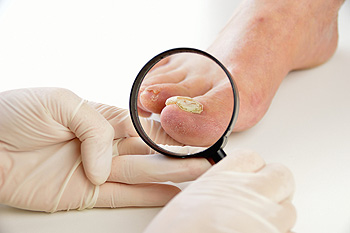 The condition that is known as toenail fungus is considered to be contagious. The fungus that causes this nail infection typically thrives in warm and moist environments. These places may include public pools, shower room floors, locker rooms, and surrounding areas. When appropriate footwear is worn, the chances of getting toenail fungus may be reduced. The infection may also develop if patients have wet nails for extended periods of time, sometimes due to wearing sweaty shoes for consecutive days. Symptoms of toenail fungus may include the nail becoming thick, in addition to the nail turning a yellow, green, or brown color. Research has indicated that when early treatment is implemented, damage to the nail may be minimized. If you feel you have developed toenail fungus, it is important that you consult with a podiatrist who can advise you on proper treatment options.
The condition that is known as toenail fungus is considered to be contagious. The fungus that causes this nail infection typically thrives in warm and moist environments. These places may include public pools, shower room floors, locker rooms, and surrounding areas. When appropriate footwear is worn, the chances of getting toenail fungus may be reduced. The infection may also develop if patients have wet nails for extended periods of time, sometimes due to wearing sweaty shoes for consecutive days. Symptoms of toenail fungus may include the nail becoming thick, in addition to the nail turning a yellow, green, or brown color. Research has indicated that when early treatment is implemented, damage to the nail may be minimized. If you feel you have developed toenail fungus, it is important that you consult with a podiatrist who can advise you on proper treatment options.
For more information about treatment, contact one of our podiatrists of Apple Podiatry Group. Our doctors can provide the care you need to keep you pain-free and on your feet.
Toenail Fungus Treatment
Toenail fungus is a condition that affects many people and can be especially hard to get rid of. Fortunately, there are several methods to go about treating and avoiding it.
Antifungals & Deterrence
Oral antifungal medicine has been shown to be effective in many cases. It is important to consult with a podiatrist to determine the proper regiment for you, or potentially explore other options.
Applying foot powder on the feet and shoes helps keep the feet free of moisture and sweat.
Sandals or open toed shoes – Wearing these will allow air movement and help keep feet dry. They also expose your feet to light, which fungus cannot tolerate. Socks with moisture wicking material also help as well.
If you have any questions please feel free to contact our offices located in Arlington Fort Worth, And Flower Mound, TX . We offer the newest diagnostic tools and technology to treat your foot and ankle needs.
Treating Toenail Fungus
Fungal infection of the toenail, or onychomycosis, typically appears as a gradual change in a toenail’s texture and color that involves brittleness and darkening. The fungal infection itself occurs beneath the surface of the nail. Aside from discoloration, other symptoms include the collection of debris beneath the nail plate, white marks on the nail plate, and a foul odor emanating from the nail. If ignored, the infection can spread into other nails and the skin; in severe cases, it can hinder one’s ability to work or walk.
The toenails are particularly vulnerable to contracting infection in moist environments where people are likely to be walking barefoot, such as around swimming pools, public showers, and locker rooms. Fungal infection may also be more likely to occur in nail beds that have been injured, and sufferers of chronic diseases such as diabetes, circulatory problems, or immunodeficiency conditions are particularly prone to developing fungal nails.
Fungal nails can be primarily prevented by practicing proper hygiene and regularly examining the feet and toes. Carefully washing the feet with soap and water and thoroughly drying the feet afterwards are essential. Other tips include wearing shower shoes in public areas, changing shoes and socks daily, keeping toenails clipped at a short length, wearing breathable shoes that fit properly, wearing moisture-wicking socks, and disinfecting home pedicure tools and instruments used to cut nails.
Fungal nail treatment may vary between patients and the severity of the condition. Your podiatrist may suggest a daily routine of cleansing that spans over a period of time to ease mild infections. Over-the-counter or prescription antifungal agents may also be prescribed, including topical and/or oral medications. Debridement, or the removal of diseased nail matter and debris, may also be performed. In more severe cases, surgical treatment may be needed. In some instances, the temporary removal of the fungal nail allows for the direct application of a topical antifungal to the nail bed. In other cases, a chronically painful fungal nail that has not responded to other treatments may be permanently removed; this allows the infection to be cured and avoids the growth of a deformed nail.
Risk Factors for Heel Spurs
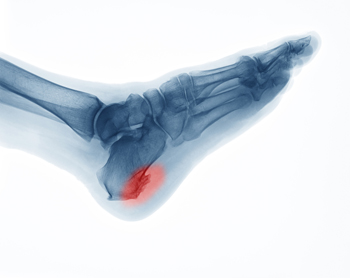 Heel spurs are caused by calcium deposits that build up beneath the heel. These calcium deposits cause bony protrusions that can cause discomfort or pain. There are some risk factors that increase the chances of developing a heel spur, and one of these risk factors is participating in athletic activities. For example, running and jumping can strain the heel and arch of the foot. If the heel is exposed to trauma, that also increases the risk of a heel spur; trauma usually involves the bruising or tearing of the membrane that covers the heel. Gender, age, and weight also affect the likelihood of developing heel spurs. Heel spurs are more common in women than men; and the older an individual is, the more at risk they are. Obesity can also be linked to heel spurs due to the additional pressure being placed on the foot. If you think you may have a heel spur, speak with a podiatrist for a proper diagnosis and to learn about treatment.
Heel spurs are caused by calcium deposits that build up beneath the heel. These calcium deposits cause bony protrusions that can cause discomfort or pain. There are some risk factors that increase the chances of developing a heel spur, and one of these risk factors is participating in athletic activities. For example, running and jumping can strain the heel and arch of the foot. If the heel is exposed to trauma, that also increases the risk of a heel spur; trauma usually involves the bruising or tearing of the membrane that covers the heel. Gender, age, and weight also affect the likelihood of developing heel spurs. Heel spurs are more common in women than men; and the older an individual is, the more at risk they are. Obesity can also be linked to heel spurs due to the additional pressure being placed on the foot. If you think you may have a heel spur, speak with a podiatrist for a proper diagnosis and to learn about treatment.
Heel spurs can be incredibly painful and sometimes may make you unable to participate in physical activities. To get medical care for your heel spurs, contact one of our podiatrists from Apple Podiatry Group. Our doctors will do everything possible to treat your condition.
Heels Spurs
Heel spurs are formed by calcium deposits on the back of the foot where the heel is. This can also be caused by small fragments of bone breaking off one section of the foot, attaching onto the back of the foot. Heel spurs can also be bone growth on the back of the foot and may grow in the direction of the arch of the foot.
Older individuals usually suffer from heel spurs and pain sometimes intensifies with age. One of the main condition's spurs are related to is plantar fasciitis.
Pain
The pain associated with spurs is often because of weight placed on the feet. When someone is walking, their entire weight is concentrated on the feet. Bone spurs then have the tendency to affect other bones and tissues around the foot. As the pain continues, the feet will become tender and sensitive over time.
Treatments
There are many ways to treat heel spurs. If one is suffering from heel spurs in conjunction with pain, there are several methods for healing. Medication, surgery, and herbal care are some options.
If you have any questions feel free to contact our offices located in Arlington Fort Worth, And Flower Mound, TX . We offer the latest in diagnostic and treatment technology to meet your needs.
